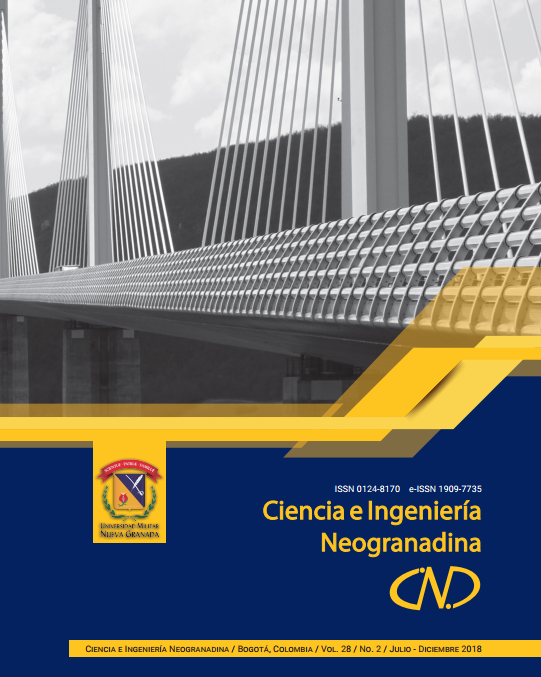Effect of the concentration of iron in the properties of Nb2O5 with posible photocatalitic application
Abstract
At present, it is searching to develop low gap band energy compounds to be applied in photocatalysis. Niobium pentoxide was doped with iron in order to establish the relationship between its structural, morphological and surface properties, and possible photocatalytic applications. Nb2O5 doped with Fe (at 2.5%, 5% and 10%, percentage by weight) powders were prepared through the Pechini method, this seeking to establish the appropriate synthesis conditions for the formation of Nb2O5: Fe particles. The powders were sintered at 600°C and 700°C for 2 hours in air and afterwards were examined by TGA, XRD, SEM, UV-vis diffuse reflectance spectroscopy and by the BET method. The thermal analysis allowed establishing the behavior of the percentage of weight loss as a function of temperature in the precalcined samples. Results obtained for non-doped oxide were compared with those of Nb2O5 doped with Fe to analyze its crystalline properties. The Nb2O5 doped with Fe at 2.5% and 5% diffractograms, subjected to 700°C, were similar to that of the non-doped oxide indicating that Nb was replaced by Fe and, therefore, there are not significant variations in the oxide structure. The crystallite size of the Nb2O5 doped with Fe nanostructured particles it was increased in all cases, when the sintering temperature was increased from 600°C to 700°C. The gap band energy of Nb2O5:Fe decreased with the temperature increase for the concentrations of 2.5% and 5%. The SBET value increased with the iron concentration increase. The sample Nb2O5:Fe5%, calcined at 700°C, showed an Eg of approximately 2.69 eV and structural and superficial characteristics that make it promising for tests of photocatalytic performance.Downloads
References
Fujishima A., Honda K. (1972). Electrochemical photolysis of water at a semiconductor electrode. Nature, 238, pp. 37-38. https://doi.org/10.1038/238037a0
Prado A. G. S., Bolson L. B., Pedroso C. P., Moura A. O., Costa L. L. (2008). Nb2O5 as efficient and recyclable photocatalyst for indigo carmine degradation. Applied Catalysis B: Environmental, 82 (3-4), pp. 219-224. https://doi.org/10.1016/j.apcatb.2008.01.024
Lopes O. F., Paris E. C., Ribeiro C. (2014). Synthesis of Nb2O5 nanoparticles through the oxidant peroxide method applied to organic pollutant photodegradation: A mechanistic study. Appl. Catal. B Environ., 144, pp. 800-808. https://doi.org/10.1016/j.apcatb.2013.08.031
Furukawa S., Ohno Y., Shishido T., Teramura K., Tanaka T. (2013). Reaction Mechanism of Selective Photooxidation of Amines over Niobium Oxide: Visible-Light-Induced Electron Transfer between Adsorbed Amine and Nb2O5. J. Phys. Chem. C, 117 (1), pp. 442-450. https://doi.org/10.1021/jp310501h
Shishido T. et al. (2009). Mechanism of Photooxidation of Alcohol over Nb2O5. J. Phys. Chem. C, 113 (43), pp. 18713-18718. https://doi.org/10.1021/jp901603p
Chen X. et al. (2007). Enhanced activity of mesoporous Nb2O5 for photocatalytic hydrogen production. Appl. Surf. Sci., 253 (20), pp. 8500-8506. https://doi.org/10.1016/j.apsusc.2007.04.035
Lai F., Lin L., Huang Z., Gai R., Qu Y. (2006). Effect of thickness on the structure, morphology and optical properties of sputter deposited Nb2O5 films. Applied Surface Science, 253 (4), pp. 1801–1805. https://doi.org/10.1016/j.apsusc.2006.03.014
Wang Y. D., Yang L. F., Zhou Z. L., Li Y.F., Wu X.H. (2001). Effects of calcining temperature on lattice constants and gas-sensing properties of Nb2O5. Materials Letters, 49 (5), pp. 277-281. https://doi.org/10.1016/S0167-577X(00)00384-0
Rajan J., Velmurugan T., Seeram R. (2009). Metal oxides for dye-sensitized solar cells. J. Am. Ceram, Soc. 92 (2), pp. 289-291. https://doi.org/10.1111/j.1551-2916.2008.02870.x
Lira-Cantua M., Krebsb F.C. (2006). Hybrid solar cells based on MEH-PPV and thin film semiconductor oxides (TiO2, Nb2O5, ZnO, CeO2 and CeO2–TiO2): Performance improvement during long-time irradiation. Sol. Energy Mater. Sol. Cells, 90 (14), pp. 2076–2086. https://doi.org/10.1016/j.solmat.2006.02.007
Nowak I., Ziolek M. (1999). Niobium compounds: preparation, characterization, and application in heterogeneous catalysis chemical reviews. Chem. Rev., 99 (12), pp 3603–3624. https://doi.org/10.1021/cr9800208
Schäfer H., Gruehn R., Schulte F. (1966). The modifications of Niobium Pentoxide. Angewandte Chemie International Edition in English, 5 (1), pp. 40-52. https://doi.org/10.1002/anie.196600401
Herval L.K.S. et al. (2015). The role of defects on the structural and magnetic properties of Nb2O5. Journal of Alloys and Compounds, 653, pp. 358-362. https://doi.org/10.1016/j.jallcom.2015.09.019
Falcomer D., Speghini A., Ibba G., Enzo S., Cannas C., Musinu A., Bettinelli M. (2007). Morphology and Luminescence of Nanocrystalline Nb2O5 Doped with Eu3+. Journal of Nanomaterials, 2007. https://doi.org/10.1155/2007/94975
Hu B., Liu Y. (2015). Nitrogen-doped Nb2O5 nanobelt quasi-arrays for visible light photocatalysis. Journal of Alloys and Compounds, 635, pp. 1-4. https://doi.org/10.1016/j.jallcom.2015.02.109
Ramanjaneya Reddy G., Chennakesavulu K. (2014). Synthesis and characterization of Nb2O5 supported Pd(II)@SBA15: Catalytic activity towards oxidation of benzhydrol and Rhodamine-B. Journal of Molecular Structure, 1075 (5), pp. 406-412. https://doi.org/10.1016/j.molstruc.2014.06.090
Honga S. H., Kwonb S. N., Baea J.S., Song M. Y. (2009). Hydrogen-storage properties of gravity cast and melt spun Mg–Ni–Nb2O5 alloys. International journal of hydrogen energy, 34 (4), pp. 1944-1950. https://doi.org/10.1016/j.ijhydene.2008.12.015
Barbosa López A. L., Castro Sierra I. M. (2012). Estudio catalítico comparativo de los sistemas TiO2 y Nb2O5•3H2O en la degradación de cianuro en función del tipo de oxidante. Ingeniería y Ciencia, 8 (16), pp. 257-280.
Pechini M.P. Method of preparing lead and alkaline Earth titanates and niobates and coating method using the same to form a Capacitor. US Patent Specification 3330697.
Raba A. M., Barba-Ortega J., R. Joya M. (2015). The effect of the preparation method of Nb2O5 oxide influences the performance of the photocatalytic activity. Appl. Phys. A, 119 (3), pp. 923-928. https://doi.org/10.1007/s00339-015-9041-3
Kato K, Tamura S. (1975). Die Kristallstruktur von T-Nb2O5. Acta Crystallographica Section B, B31, pp. 673-677. https://doi.org/10.1107/s0567740875003603
Lessing P. (1989). Mixed-cations oxide powders via polymeric precursors. American Ceramic Society Bolletin, 68(5), pp. 1002-1007.
Escobedo Morales A., Sánchez Mora E., and Pal U. (2007). Use of diffuse reflectance spectroscopy for optical characterization of un-supported nanostructures. Revista Mexicana de Física S, 53 (5), pp. 18-22.











